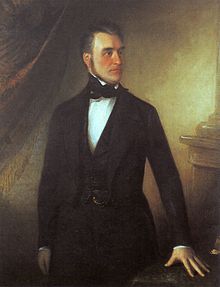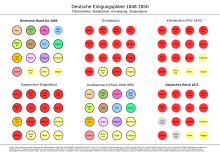Double waistband
A thought from 19th century German history is referred to as a double bond (also known as the “Gagern double bond” or “narrower and wider bond”). In the German Confederation there were politicians who wanted to found a German federal state . However, it became clear to them that Austria could not or did not want to belong to this federal state, neither the whole of Austria nor the federal regions of Austria.
Therefore, all German states should form a small German federal state, the narrower federation. This federal state should form a state union together with Austria, the further federation. The Doppelbund did not come into being in 1849: Austria did not want to be forced out of Germany, and Prussia only wanted to form a federal state if it were made more conservative than the Frankfurt constitution provided for. The idea of the double alliance came up again in the future. The German-Austrian dual alliance of 1879 can be interpreted as a certain echo of the thought.
Restoration and pre-march
Before and when the German Confederation was founded in 1815, there had been various plans for the federal territory. As early as 1812, the Prussian statesman Freiherr vom Stein was considering a "double alliance". Germany was to be divided along the Main Line : Prussia was to dominate in the north and Austria to dominate the other states in the south, establishing a closer federal relationship. These other states should not have had their own foreign policy. North Germany and South Germany should be linked by a confederation of states.
German Empire 1848/1849

The liberal politician Heinrich von Gagern had already formulated the idea of a double alliance in 1846. The idea became important when the German question was set in motion by the March Revolution of 1848. In May 1848 the German National Assembly met in Frankfurt, elected by the residents of the federal territory including those parts of Austria that belonged to the federal territory. In June the National Assembly established a provisional constitutional order for the emerging federal state, which was already named German Empire .
At that point in time it still seemed natural that the federal parts of Austria should be part of the German federal state. But over the months it became obvious that the Austrian emperor did not want to know anything about it. According to the National Assembly, the Austrian emperor could have remained the ruler of the federal state as well as of other countries (such as Hungary or Lombardy-Veneto). The federal state of Austria should have had its own state constitution and administration, separate from the constitutions and administrations in the other states. A corresponding regulation was then incorporated into the German constitution of March 28, 1849.
The Austrian emperor strictly rejected such a division of his national territory. He feared that a mere personal union , i.e. the emperor as the sole bracket, would not hold the present Austria together permanently. The imperial government considered it more interesting that the German Confederation should instead remain as a federation of states and that all parts of Austria would have become federal territory. The military protection would have been extended to all of Austria. In return, Austria would have admitted that the German Confederation would have been expanded somewhat, with new tasks such as the creation of uniform weights and measures and a customs union . These are the main ideas of the Greater Austria Plan of March 9, 1849.
In the last months of 1848 the relationship between the German National Assembly and the Austrian government had deteriorated dramatically. On December 17, 1848, the German Reich received a new government: the Gagern cabinet replaced the cabinet of the Austrian Schmerling . Heinrich von Gagern from Hessen-Darmstadt aspired to a small German federal state and officially presented the plan for a double alliance to the National Assembly on December 18. This was intended to reassure the Greater German MPs who did not want to do without Austria. The ties to Austria would not be completely severed.
But the Austrian Emperor issued a centralized constitution for all of Austria at the beginning of March, and the Greater Austria Plan followed. Thus the political ground was finally removed from the Greater Germans, and the National Assembly agreed on a Little German Reich constitution. In April the Prussian king refused the small German imperial crown that had been awarded to him. This meant that neither the closer nor the wider covenant had come about.
Erfurt Union

When Prussia tried to form the " Erfurt Union " in 1849/1850, it initially wanted a double alliance with Austria. To this end, the Prussian government made contact with Austria in the spring of 1849. At that time the expression for the closer federation, the federal state, was still “German Reich”, and for the wider federation with Austria “Union”. It was only later that the desired federal state was given the name “German Union” (mostly “Erfurt Union” in historical studies). Austria rejected such ideas, however, because it saw its previous supremacy in Germany threatened and feared that the balance within Germany would have shifted too much in the direction of Prussia.
For a time Austria would at best have allowed Prussia to form a certain closer league within Germany. However, this was not allowed to be a federal state and, for example, should not have had a directly elected parliament. Instead, the members of the affected state parliaments could have formed a kind of representative body. Austria also refused to expand the Erfurt Union at that time to include states such as Bavaria that had not yet joined.
End of the German Confederation and Outlook
In the years after 1851, especially in the reaction era , Austria and Prussia again worked together in the German Confederation. Nevertheless, there were still politicians in Prussia who supported a small German federal state. The idea of a double covenant was occasionally raised.
The German Confederation existed until 1866. At the latest when the so-called German Empire was founded, Austria left Germany. In 1879, however, there was a military alliance between the German Empire and Austria-Hungary: the two alliance. In a certain way, one can see an echo of the double covenant here, even though the double covenant was a looser union than the wider covenant would have been.
Web links
supporting documents
- ^ Ernst Rudolf Huber: German Constitutional History since 1789. Volume I: Reform and Restoration 1789 to 1830. 2nd edition, Verlag W. Kohlhammer, Stuttgart [et al.] 1967, p. 512/513.
- ^ Frank Möller: Heinrich von Gagern. A biography. Habilitation thesis. University of Jena, 2004, pp. 143–145.
- ^ Ernst Rudolf Huber: German constitutional history since 1789. Volume II: The struggle for unity and freedom 1830 to 1850. 3rd edition. W. Kohlhammer, Stuttgart et al. 1988, pp. 886-888.
- ^ Ernst Rudolf Huber: German constitutional history since 1789. Volume II: The struggle for unity and freedom 1830 to 1850. 3rd edition, Verlag W. Kohlhammer, Stuttgart [et al.] 1988, p. 901/902.
- ^ Frank Möller: Heinrich von Gagern. A biography. Habilitation thesis. University of Jena, 2004, p. 413/414.
